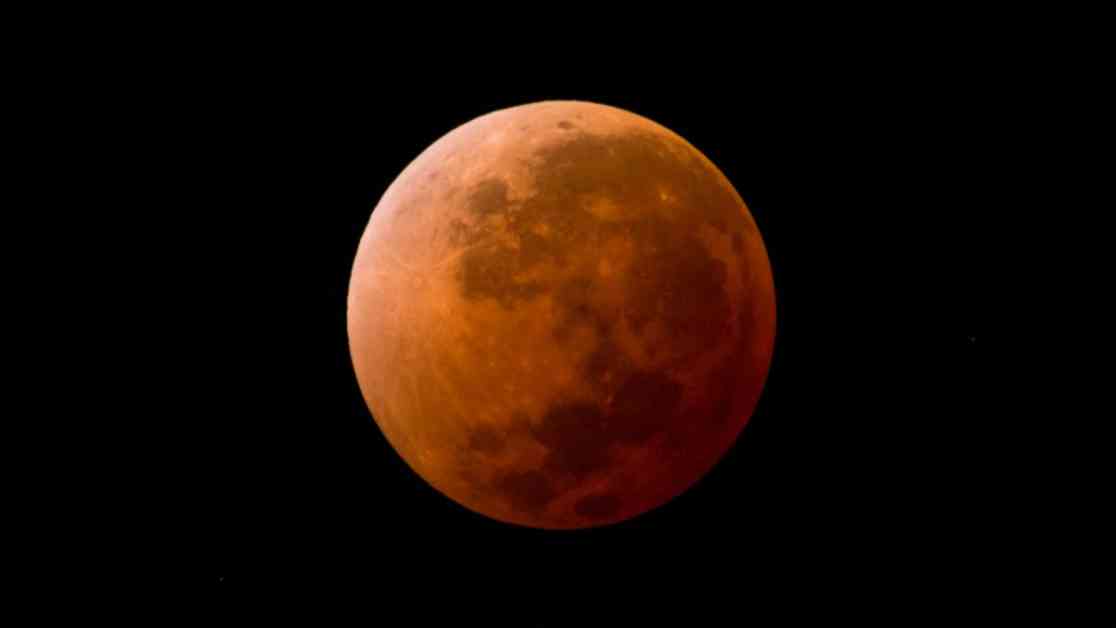A rare celestial event is set to captivate sky-watchers in the Chicago area this weekend—the total lunar eclipse. As the moon gracefully transitions into a fiery red hue, NASA predicts the eclipse will reach its peak during the late hours of Friday. For those eager to witness this awe-inspiring phenomenon, Shannon Schmoll, the director of Abrams Planetarium at Michigan State University, assures that clear skies will offer a perfect view.
The total eclipse is expected to commence on Thursday evening and progress towards totality in the early hours of Friday morning. Unlike a solar eclipse, the lunar eclipse can be viewed with the naked eye, eliminating the need for specialized equipment or eclipse glasses. To catch a glimpse of this celestial ballet, all you need to do is step outside and look up at the night sky.
Adler Planetarium in Chicago recommends finding an unobstructed spot to witness the eclipse, away from tall buildings or trees. Fortunately, the NBC 5 Storm Team forecasts clear skies during the eclipse period, promising an uninterrupted view of this cosmic spectacle.
When to Catch the Lunar Eclipse?
According to NASA’s timetable, the eclipse will kick off just before 11 p.m. CT on Thursday, marking the beginning of the moon’s gradual darkening. By midnight, a partial eclipse will commence, with a noticeable section of the moon’s surface obscured by the Earth. The much-anticipated “blood moon” phase will make its grand entrance around 1:26 a.m. CT on Friday, displaying vivid reddish and orange hues. This captivating display will last for about an hour and can be observed with the naked eye or through a telescope, weather permitting.
The pinnacle of the eclipse is expected close to 2 a.m. CT, offering a mesmerizing sight for all onlookers. The total eclipse itself will linger for slightly over an hour, concluding around 2:31 a.m. CT. It’s a once-in-a-lifetime opportunity to witness the moon draped in a mesmerizing array of colors against the backdrop of the night sky.
Unlocking the Mystery of the Lunar Eclipse
A total lunar eclipse unfolds when the moon, Earth, and sun align perfectly, plunging the moon into the Earth’s shadow. During a total eclipse, the moon ventures into the Earth’s “umbra,” the darkest segment of the Earth’s shadow. Despite not entirely blocking the sunlight, the Earth allows only a hint of light to pass through, casting a spectacular orange or red tint on the lunar surface, creating the famous “Blood Moon.”
The moon’s transformation into a coppery red hue as the stray sunlight filters through Earth’s atmosphere is truly a sight to behold. On the contrary, a partial lunar eclipse showcases Earth’s shadow seemingly taking a bite out of the moon, offering a different yet equally captivating visual experience.
Lunar and solar eclipses grace the skies four to seven times annually, as per NASA’s records. The last total lunar eclipse was observed in 2022, while a partial lunar eclipse treated viewers in the Americas, Africa, and Europe last September. These celestial events serve as a poignant reminder of the wonders of our universe.
What gives the moon its mesmerizing orange-red appearance during a lunar eclipse? The sun’s light, despite appearing white, consists of a spectrum of colors that interact differently with Earth’s atmosphere. The varying wavelengths of light can diffuse in the atmosphere or travel directly through it, creating an array of hues.
During daylight hours, the sky appears blue due to the scattering of blue light in the atmosphere. As the sun transitions towards sunset, the direct path of the sunlight through the atmosphere results in an orange or red tint, a phenomenon mirrored during a lunar eclipse. The red or orange light hitting the moon’s surface during a lunar eclipse is a direct result of this natural play of light.
What exactly is a Blood Moon? Adler Planetarium clarifies that the term “blood moon” is an informal way to describe a total lunar eclipse and is not a scientific term. However, its usage has gained popularity due to the striking red or orange appearance of the moon during the totality phase of the eclipse. Today, the phrases “blood moon” and “lunar eclipse” are often used interchangeably, embodying the fascination and wonder of these celestial events.
The spectacle of the total lunar eclipse promises a breathtaking display of nature’s artistry, inviting all to gaze up at the heavens and marvel at the beauty of our universe. Don’t miss this rare opportunity to witness the moon cloaked in shades of red and orange against the canvas of the night sky.












